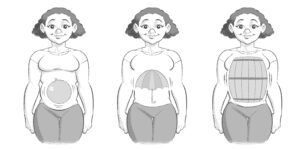 You hear so often that you should exhale on exertion when lifting or exercising, but is it true? Ultimately, the answer is yes, but it may depend on what your goal is in a particular movement. And other breath patterns can be helpful, too.
You hear so often that you should exhale on exertion when lifting or exercising, but is it true? Ultimately, the answer is yes, but it may depend on what your goal is in a particular movement. And other breath patterns can be helpful, too.
Holding your Breath is the Worst
When exercising you definitely don’t want to hold your breath. Easier said than done, I know, but breathing really makes a difference. When you hold your breath, you reduce the amount of oxygen that flows to your muscles. Your muscles need oxygen for strength or endurance movements. Also, holding your breath while exercising can increase blood pressure, sometimes to dangerous levels, and it can lead to light headedness.
In addition after holding your breath, when it is finally time to breathe, it’s more vital that you expel carbon dioxide than that you take in oxygen. That means you will blow out before you inhale, which just delays your ability to get oxygen to the muscles even further.
Holding your breath can easily become the Valsalva Maneuver. You may never have heard of that, but you’ve probably done it. If you’ve ever held your nose while blowing out to pop your ears or bared down when you are taking a bowel movement, you’ve done the Valsalva maneuver. It can actually play a role in helping with certain heart conditions, but it’s not a great choice when exercising (or pooping). And for anyone dealing with chronic lower back pain or disc issues, it can often increase pain and symptoms. So breathe, breathe, breathe, when you exercise (and poop).
Exhale on Exertion
Exhaling gives you power. In fact, when people grunt, groan, or shout during feats of strength they exhibit additional strength. Try to grunt, groan, or shout while inhaling. It just doesn’t happen. Attempting a strength exercise (like a squat, lifting heavy weights, or needing to lug something while doing yard work) will come with more power if you exhale.
So the noisy breather in your fitness class or someone who moans and groans is finding more power within themselves. I’ve always known I like it when my classes moan. But I think many people are often too shy to make noise when exercising. And many people, myself included, eyeroll when we hear the guy grunting to do bicep curls at the gym. It seems excessive. But there is something to it. It’s turning movement into a more full body exercise. Adding vocalization, in addition to increasing strength, adds vibration, which also may have a benefit to our movement in ways we barely understand.
What About the Back?
There is a lot of evidence that doing a diaphragmatic 3-dimensional belly breath (which increases intra abdominal pressure) helps stabilize and support the low back when you inhale. Hmm….this is where things get tricky. Should I inhale or exhale then? When I’m lifting something heavy do I want to exhale and grunt to produce strength in my legs or do I want to inhale and have my lower back supported?
Oh, Mylanta! You see how aspects of the body we think should be simple get really complicated?
Here’s the truth. The only way you are going to get the support for your spine on an inhale is if you can control your breath well enough to do a functional, diaphragmatic breath. Because it is not the inhale that supports the spine, it’s the intra abdominal pressure created by the inhale, which you don’t create on a shallow chest breath. If you inhale and you tend to breathe into your chest or shoulders, you aren’t supporting your back. So, if you aren’t sure how to do a diaphragmatic breath properly, definitely stick with an exhale. But don’t completely lose track of diaphragmatic breathing. It can be a really useful tool for spinal health and stress reduction. It’s worth learning how to do.
Another concern about increasing intra-abodominal pressure—if your abs are not strong enough, under pressure it can increase chances of a hernia when lifting. And, if you are a lady, and you are prone to leaking urine when you jump, cough, laugh or sneeze, intra abdominal pressure can put more pressure on your pelvic floor. Guys, you are not free and clear. It will put pressure on your pelvic floor too, which isn’t great for you, there are just typically less obvious, less embarrassing results.
This doesn’t mean you should stay away from diaphragmatic breathing. Your pelvic floor is meant to move with your breath. Training the pelvic floor to activate and relax while breathing can be an incredibly helpful tool (and it can create good tone in the pelvic floor). But jumping right into an exercise and inhaling on exertion may increase your chances of leaking.
Hmm…what’s a girl or fella to do?
Conclusion: Exhale on Exertion
As a general rule, stick with exhale on exertion. It will give you more power in whatever you do. But find a time to explore diaphragmatic breathing because it is so good for so many systems. Maybe you start practicing for 5 minutes before you go to sleep, since research has shown deep, diaphragmatic breaths help relax people and help them fall asleep faster.
Also—when you feel it is safe to do so, explore different breath patterns and see how they feel in your body. Movement studies are often small so there might be moves that aren’t one size fits all. For example, in Pilates we generally cue to exhale when you round forward (flex the spine) and inhale when you bend back (extend the spine) even if the exertion is on the backbend. That’s not because it is right for every body. It is because inhaling on a backbend seems to help people backbend. Does it for you? Try it in your body and see what you think. Does it feel better, easier, harder, to inhale or exhale when you bend backwards?
Pilates class is probably a great place to play with your breath patterns, while lugging something heavy may not be. That’s the time to stick with an exhale. If you take cardio classes like kick boxing. Try throwing a punch when you inhale…it just doesn’t feel right. The exhale feels much more normal and powerful. The science and research is really helpful, but sometimes it’s beneficial to focus on what you feel in your body.
It is okay to learn what feels good to you.
Keep Reading
Here’s more on syncing breathing and pelvic floor movement.
Breathing and abdominal engagement in Pilates.
Yikes…Larynx spasms.
Keep Connected
Order Your Copy of Keep Moving Today!
Subscribe to the Keep Moving Blog
Like the Personal Euphoria Facebook page
Find us on Twitter
Follow me on Instagram
Subscribe to my YouTube Channel
